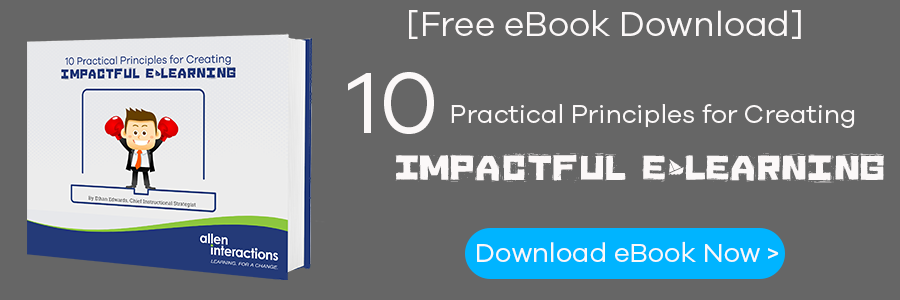Blog
Je n’en crois pas mes yeux! Unexpected E-Learning Insights in a French ...
By Ethan Edwards, Chief Instructional Strategist/ @ethanaedwards I recently had the pleasure to pay a visit to Gunston Hall in Fairfax County, ...


ELearning Design: The Eye of the Beholder
By Ethan Edwards | March 09, 2017 | Custom Learning | 0 Comments
By Ethan Edwards, Chief Instructional Strategist/ @ethanaedwards
 I recently had the pleasure to pay a visit to Gunston Hall in Fairfax County, Virginia. We had a little time to fill before heading for the airport, so we took a quick tour through this beautiful 19th Century Plantation that was the home of George Mason. Mason’s ideas formed the basis of the Virginia Declaration of Rights and later the Bill of Rights of the U.S. Constitution.
I recently had the pleasure to pay a visit to Gunston Hall in Fairfax County, Virginia. We had a little time to fill before heading for the airport, so we took a quick tour through this beautiful 19th Century Plantation that was the home of George Mason. Mason’s ideas formed the basis of the Virginia Declaration of Rights and later the Bill of Rights of the U.S. Constitution.
 I could describe the charms of the setting, but I actually want to address an original feature of the landscape design that is now lost, and how it reminded me of a particularly important aspect of designing learning experiences, particularly experiences intended for online delivery.
I could describe the charms of the setting, but I actually want to address an original feature of the landscape design that is now lost, and how it reminded me of a particularly important aspect of designing learning experiences, particularly experiences intended for online delivery.
The approach to Gunston Hall is lined on either side with an extremely long and majestic row of southern magnolia trees; these in turn are further flanked by a matching row of cedars — four parallel rows of trees in all. This arrangement of trees makes a striking impact, so it was surprising to learn on the outset of the tour that those trees were not original at all to the landscape design.
Instead, Mason had planted in that same vast open space 200 cherry trees, also arranged in four rows. But instead of being parallel, the rows radiated out from a spot on the porch in a fan shape, like spokes on a wheel. Mason took great care to order the trees planted and pruned precisely to line up perfectly, as shown here:

His intent was to play a visual trick on his guests. He would bring a guest to the center of the porch to look out across the expanse, and he would then ask, “How many trees are planted here?” The common answer was “Four.” From that perspective, only the first tree in each row was visible. Then he would smile and say, “Now take one or two steps to the side.” To the surprise of his guest, the other 196 trees would suddenly spring into view.
It’s a neat trick, even though it is hard to imagine the trees lined up so precisely that all but the first would be invisible. But it was a striking reminder to me of how perception of a new setting (or a new topic or interface) can be so dramatically impacted by how our introduction to it is designed.
The elearning design of a course includes countless decisions that control how the learner is first brought in contact with the body of skills and content he or she is about to encounter. Too often, the experience is created from the perspective of (and thus for the consumption by) someone who already knows what to expect. In truth, we need to design the experience to be most impactful and memorable to the learner for whom this is the first exposure.
Experience suggests that there is no single “right” strategy for all content areas and all learners. Sometimes, it is best to withhold complexity, allowing learners to grasp meaning or establish a perspective in a limited setting, opening into the full scope of complexity in stages. Other times, it may be appropriate to immerse the learners immediately into complex content, relying on individual curiosity and interest to focus attention.
While there is no one answer, I do know that it is essential to every instructional design to start with an analysis of the audience to gain real insight into how a new learner approaches the content at hand. Too often, instructional designers skip this analysis, or worse, assume that the audience has the same characteristics the subject matter expert had some years before, ignoring changes in training and experiences that evolved over time. Only with that learner per spective can we begin to design the interactions, navigation, and interface that will be effective. Even then, we must continue to validate our assumptions and listen to learners through early and frequent user testing and input with prototypes.
The insights of our Founding Fathers are invoked with some regularity in the public arena lately. I encourage you to use this design of George Mason’s cherry planting as a reminder of how important and gratifying it can be to include the learner’s perception and experience when crafting your own elearning designs.
LIKE WHAT YOU'VE READ? SHARE THE KNOWLEDGE WITH THIS READY-MADE TWEET!
CLICK TO TWEET: The Eye of the Beholder http://hubs.ly/H06ttnt0 #aiblog by @customelearning

About the Author: Ethan Edwards
Ethan Edwards draws from more than 30 years of industry experience as an elearning instructional designer and developer. He is responsible for the delivery of the internal and external training and communications that reflect Allen Interactions’ unique perspective on creating Meaningful, Memorable, and Motivational learning solutions backed by the best instructional design and latest technologies.
Comments
Would you like to leave a comment?
Related Blog Posts

By: Ethan Edwards | Apr, 2016
Category: Custom Learning

Blog
A Commencement Address for e-Learning
By Ethan Edwards, Chief Instructional Strategist/ @ethanaedwards I recently had the pleasure to pay a visit to Gunston Hall in Fairfax County, ...
By: Ethan Edwards | May, 2015
Category: Custom Learning, Strategic Consulting

Blog
The e-Learning Puzzle: Don't Feel DOWN; Get Your Message ACROSS
By Ethan Edwards, Chief Instructional Strategist/ @ethanaedwards I recently had the pleasure to pay a visit to Gunston Hall in Fairfax County, ...
By: Ethan Edwards | Sep, 2014
Category: Custom Learning

